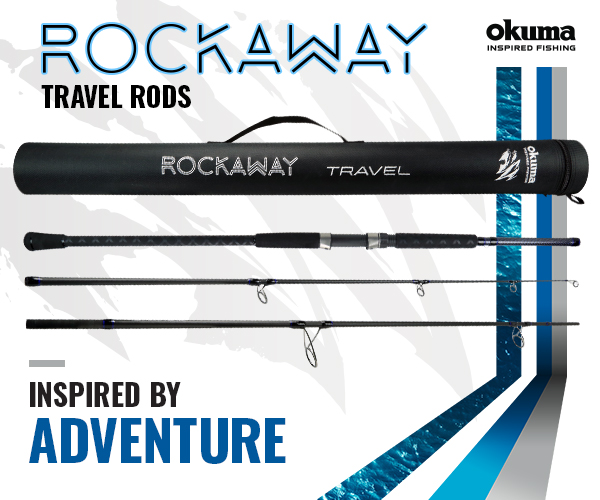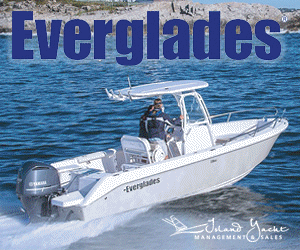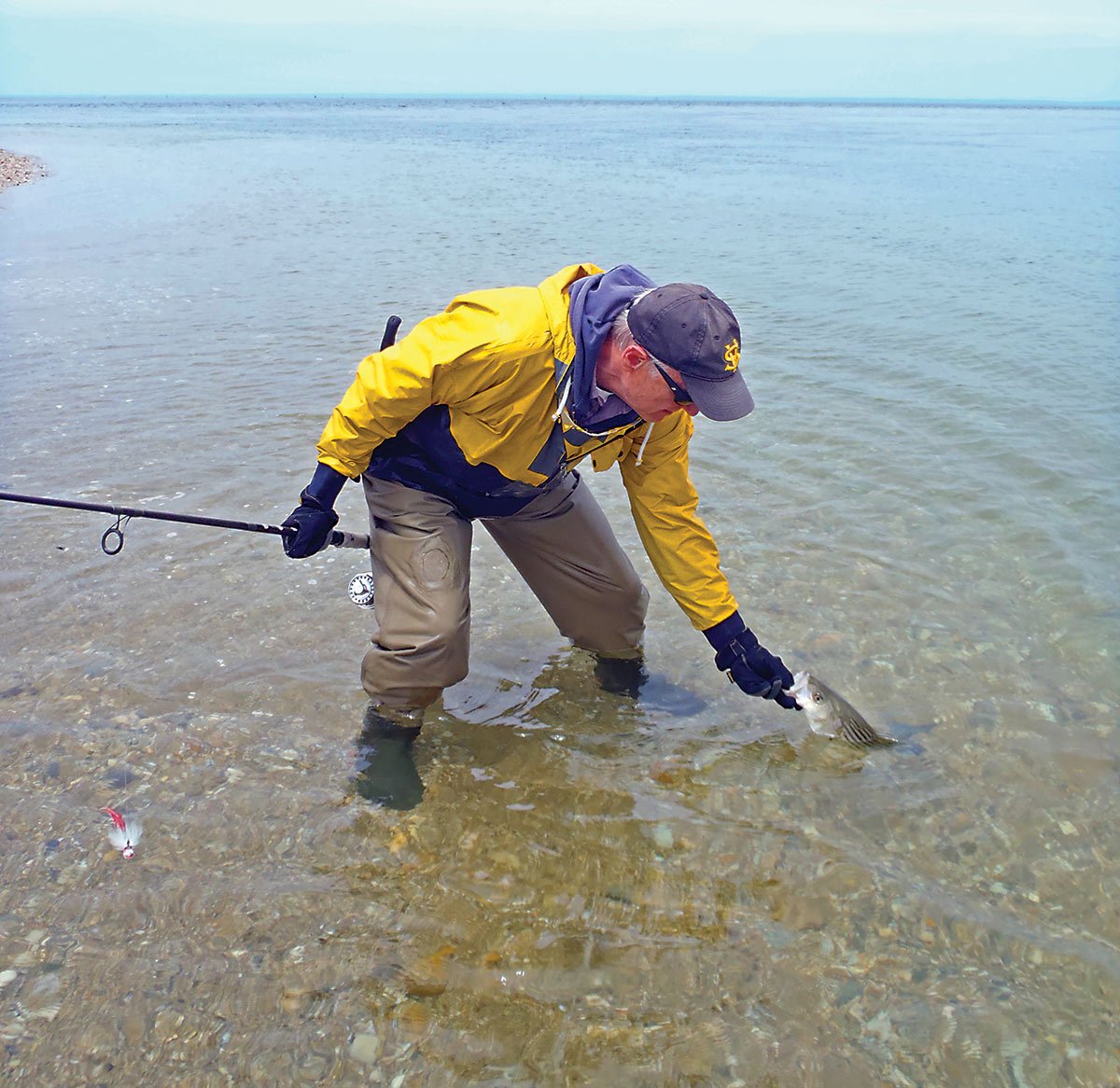
Not playing by the book may be the key to culling some bigger stripers while other casters are fixated on catching schoolies.
Each year, stripers invade Little Neck Bay in late March or early April as the sun moves higher in the sky, and a dark heat-absorbing mud bottom warms the water. As water temperatures rise, sand eels and bunker move out of the deeper water nearby and enter the bay with stripers hot on their tails.
There’s a “book” on how to fish the bay in early season, “written” over decades by many good beach rats, and accepted as the “rules.” But is this “book” accurate or complete? Most anglers are well-acquainted with the established approach that includes light tackle, small lures and thin lines. But did you know some surfcasters hunt big fish in the bay as early as late March using tackle and lures that defy the “book?” Did you know that this rebellion has been going on since the 1950s?
Frech’s Approach
When I joined High Hill Striper Club in 1973, I met Jack Frech. For those of you who don’t know about Frech, he was one of the preeminent surf anglers of his day, very inventive and a hard worker. Some of his innovative approaches included using bottle plugs and darters at Montauk way, way back, the use of a wet suit, and designing and making his own lures intended for specific fishing situations. I was never close to Jack, but as a fellow club member I had the chance to talk fishing with him on occasion as well as commission him to write a series of articles on plug making for The Fisherman. These contacts afforded me an opportunity to listen and learn, and one of the areas I learned a little about was how he fished in Little Neck Bay. An old school surf angler, Jack relinquished information sparingly, but I was able to glean some insights. Gradually, I combined these tidbits with the club’s monthly contest reports and noticed he jump-started his season in April with large stripers. I concluded his two keys to early season success were to spend a lot of hours fishing in Little Neck Bay, and the use of large plugs that imitated adult bunker. Unfortunately, I never followed up.
Decades later, I stood next to Marc Lazar as he used plugs and caught a 20-pound striper. Again, I didn’t follow his lead. Somehow, I remained stuck in the belief that early Little Neck stripers are caught by the “book.” In retrospect, I can’t believe how reluctant I was to try and figure out how to target and catch bigger fish.
Big Baits, Big Fish
It’s easy to get stuck in a “comfortable” way of fishing, as well as accepting well-established ideas about fishing. As you now know, I did just that in Little Neck Bay for decades. Ironically, it’s something I caution my mentees and seminar attendees not to do, while being guilty sometimes, too. Feel free to point this out to me and call me stupid next time you attend one of my seminars – I deserve it!
Down to business. The non-book approach is related to the old saw about big baits, big fish. That doesn’t mean the use of a big lure is a guarantee of a big fish, as I proved last April, but I did finally get with the program last spring. However, although I threw big lures, I didn’t connect with anything bigger than 8 pounds. Yes, you’ll catch some smaller fish too because hungry stripers, despite the fish-bait mis-match, try to eat almost anything they can fit in their mouths. Yet, the guy on my right and the guy on my left did connect with bigger stripers. In 2019, I intend to concentrate on better presentations that may get me into larger fish. Perhaps, I also need to go there more often in spite of the travel and traffic involved, and that may be a more serious impediment to success.
Your Pleasure
In the end, whether you choose a 7-foot rod and small lead heads with soft plastics or stouter gear capable of casting plugs that may weigh as much as 3 ounces, is a matter of personal choice. Clearly, targeting large stripers won’t produce a lot of fish, whereas fishing with light gear and small lures can result in high fish counts. So, consider your choice will have consequences: big gear a few big fish, light gear perhaps many small fish. Can’t gripe about the lack of big fish when you never target them, and any real surf rat knows one doesn’t catch lots of big fish all the time, but there are exceptions. November 2013 comes to mind when big sand eels, good beach structure, and a major storm conspired to push schools of out-size stripers against the beach for a run that lasted 18 days. In those 18 days I caught lots of big fish. However, that type of setup is rare. In fact, in 65 years of surf fishing it was the first time I ever encountered it.
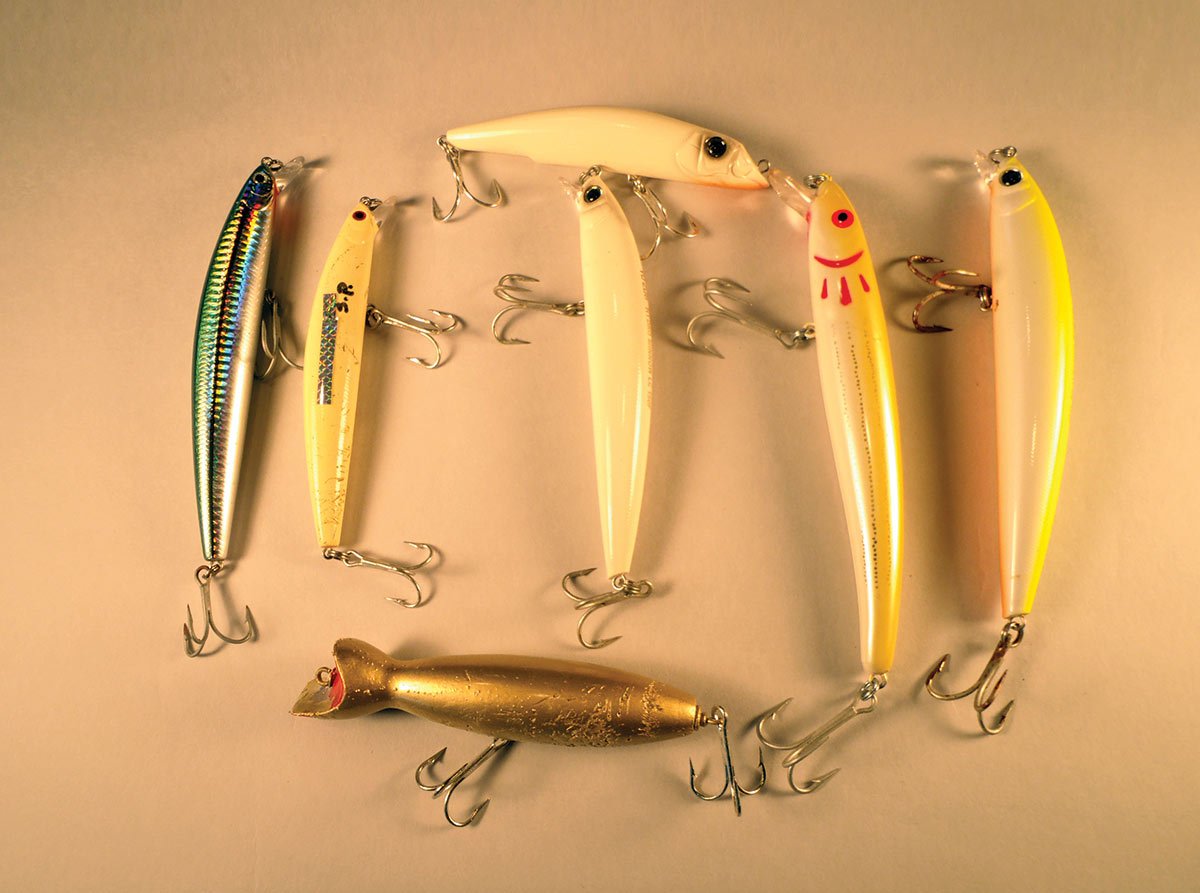
My Plan For 2019
I am confident I can improve my presentations, but what else do I have to do? First, I plan to leave my 7-foot rods home in favor of a 9-foot medium power rod, VS 200, and 20-pound test Sufix Performance Braid—maybe 15-pound test for more distance. My reasons for this tackle are two-fold. One, I’ll need to cast heavier plugs, and smaller lighter gear can only lob them. Second, my experience in 2018 convinces me that distance matters. The guys on my right and left made longer casts than I did and hooked up near the end of the cast.
The next decision involves my choice of lures. Although I have seen a few bigger stripers caught on pencil poppers and poppers over the years, it usually doesn’t happen until the end of April when the water is warmer. From late March through the early days of April, stripers seem reluctant to rise and attack a surface lure; I suppose because the cold slows their metabolism. Anyway, the lures I plan to use should match the deliberate feeding habits of the stripers.
Lure Choices
The choice of large lures in Little Neck Bay is clearly limited by shallow water and exacerbated by the fact that most good fishing occurs near low water. There are always exceptions, but I’ve consistently done better at lower stages of the tide, and only sporadically successful near high water. This means lures that grab the water and run deep will present a problem including weighted plugs and large bottle plugs and darters. In fact, any lure that runs deeper than 4 feet will bounce bottom and stir up the muddy sediment. That’s okay up to a point. However, and sadly, the bottom of Little Neck Bay is littered with garbage including old water-logged wood, discarded tires, scattered rocks, loops of cable wire, concrete and rebar, all kinds of ropes that once tied boats to moorings and docks, and even the odd ball refrigerator. If you fish there a lot you’ll get to know where the clear casting lanes are and how to retrieve to avoid the junk. I also suggest not using large surface swimming lures including my beloved C-10 RedFin, because again, stripers don’t seem to want to rise to the occasion early in spring. So, my list is shortened by environmental conditions and the early moods of the fish.
Lures That Work
I like the Yo-Zuri6- and 6-3/4-inch Hydro LC Minnow, the Yo-Zuri6- and 6-1/2-inch Mag Darter, Daiwa’s 6-inch SP Pro Minnow 15F, and the 6- and 6-1/2-inch Bomber Long A Magnum. There are other lures of similar length, weight and swimming characteristics, so don’t think my choices are the only effective lures.
As far as color choices go, you guys know I’m not big on specific colors in specific situations although many other good anglers disagree. However, in this case, remember that Little Neck Bay’s water is often dingy and on breezy days can be muddy. So I use white, bone and other light colors in daylight because they are more visible and more likely to draw the attention of nearby stripers. I say nearby, because my experiences suggest that bigger fish are reluctant to move very fast or very far when water is cold. Be advised, that cold water not only inhibits their attack speed, but also the fight once hooked. Especially early, when water is coldest, they may shake their heads and pull side-ways but don’t expect long runs.
Weather Conditions
Spring weather can be, and recently has been, a bear. Lots of hard rain, cold and clouds have repeatedly delayed the onset of spring. Therefore, there is no way to know when the action will start except by trying. Keep in mind that strong cross winds and head-on winds can play havoc with a shallow muddy harbor such as Little Neck Bay. For instance, if you like to fish the north end of the bay near Fort Totten a strong south, southeast, northeast or east wind will turn the water to mud. Similarly, north, northwest and northeast winds can muddy the stretch along Cross Island Pkwy, especially the south end of the harbor near the Phragmites reeds. Frankly, I prefer either very light winds or no wind at all. I also prefer bright sunny days in late March and early April, but cloudy days at the end of April.
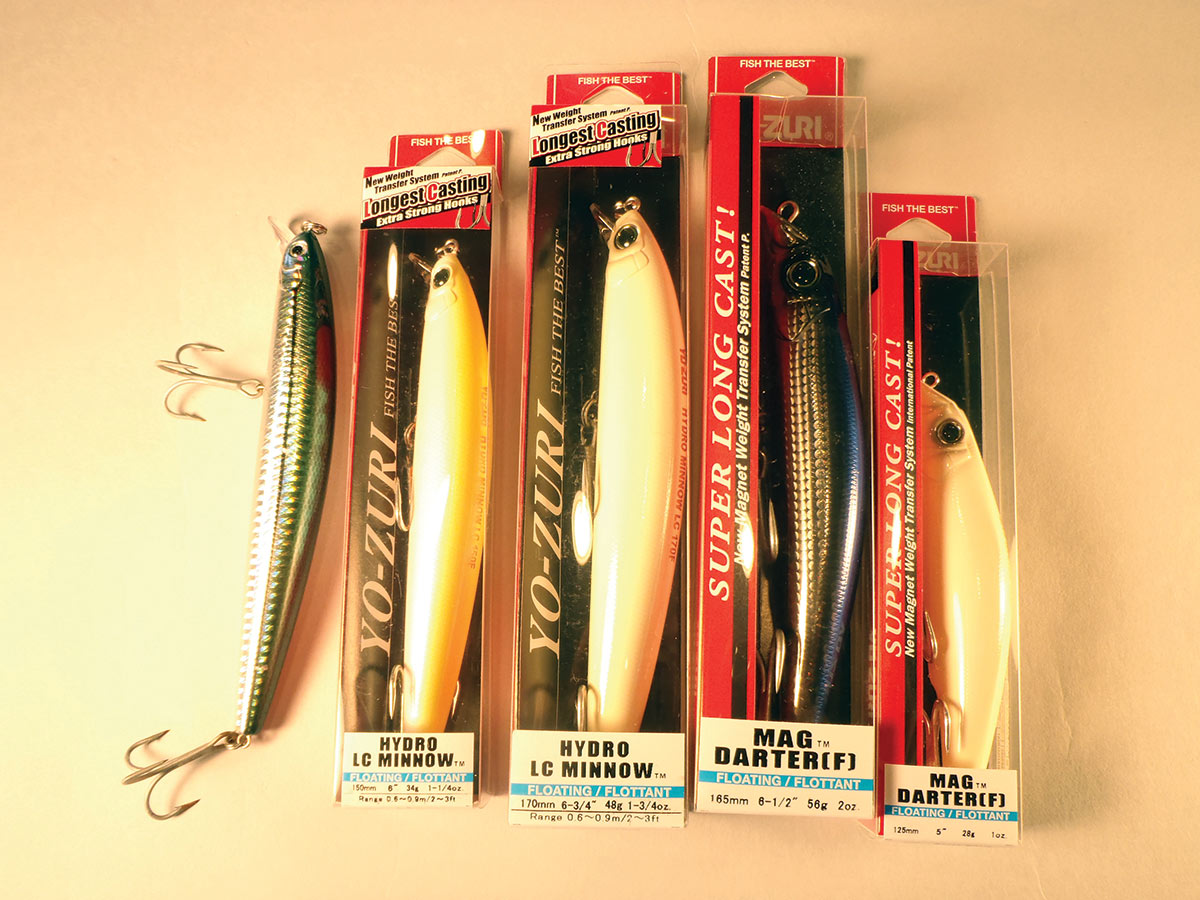
Presentations
How do I deal with the depressed metabolism of early fish? The watch word is SLOWLY! This is always true at night, but early on also true by day. For those who prefer to fish at night, you can’t retrieve slowly enough. Use the same large plugs mentioned above for bigger fish, but be patient. Let the lure sit on the surface for 10 seconds at a time, then apply small twitches, then rest, and then a slow retrieve. Continue this pattern with each cast. Should you just want to catch fish regardless of size, the usual night lures work well. These include 4- to 5-inch hard plastics, including Bombers, RedFins, Rebels, S.P. Minnows, and any other small hard plastic lures you favor.
In daylight fast retrieves are a no-no, and longer casts are needed. Use the same retrieves, but start by pulling the lure down a foot or so. Some anglers use sinking versions of the lures mentioned earlier, but keep in mind they have learned where to cast by trial and error and have lost lures learning. I don’t recommend sinking lures until you know the bay.
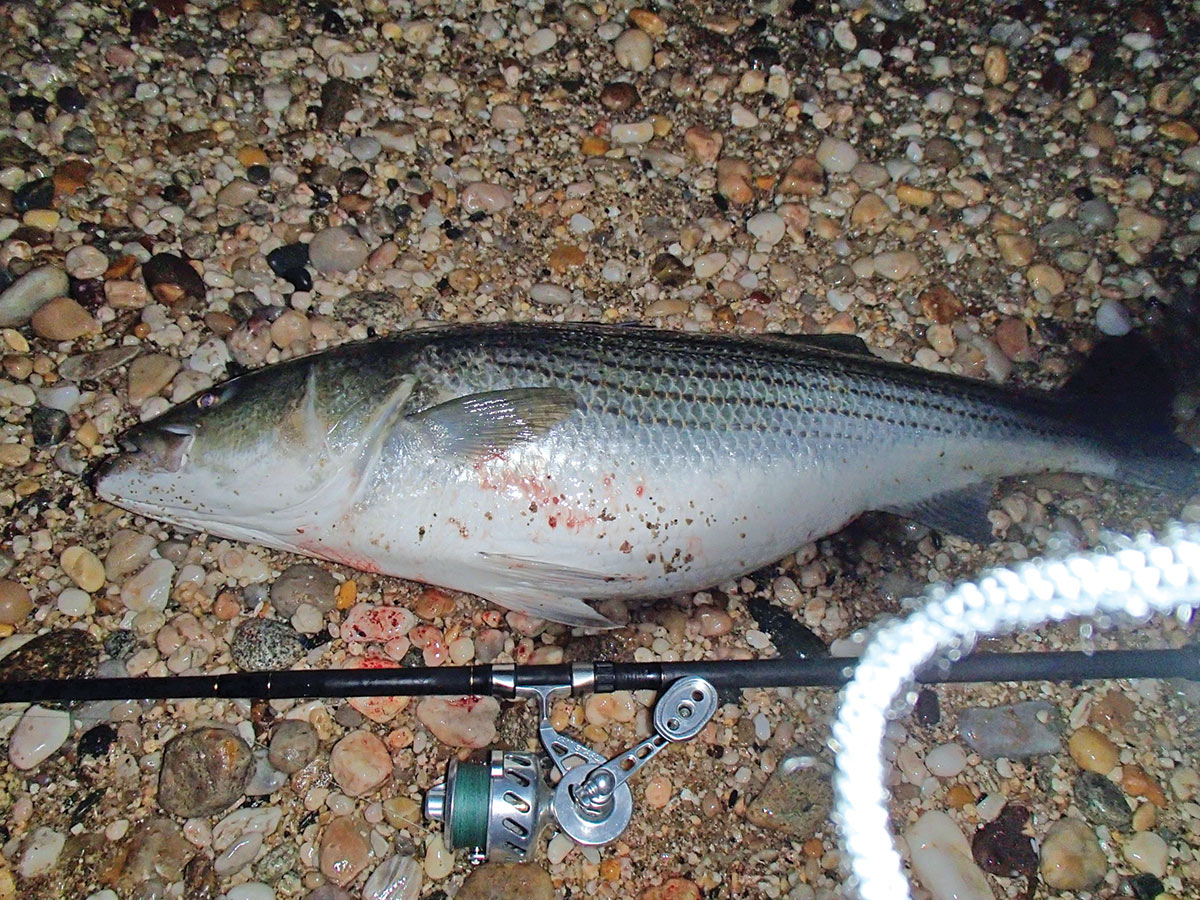
Your Choice
Sometimes glowing fishing reports from a few lucky anglers can leave the wrong impression, and I don’t want to do that here. Little Neck Bay is a wonderful early season venue, but offers no guarantee of success. I’ve been skunked many times, and had to settle for a few little fish at other times, but the potential is good. Remember too, if you insist on targeting only big fish, expect more skunked days. I go prepared with a variety of lures and adjust to the conditions to catch whatever size fish are available that day.
